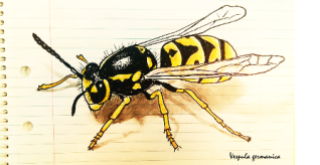
IS: Who are you, and what do you do?
TTF: My name is Tae Tanaami Fernandes. I finished my Ph.D. in 2018 at the University of Mogi das Cruzes, in the Myrmecology Laboratory of Alto Tietê, under the guidance of Drª Maria Santina de Castro Morini, where we studied ant ecology. The purpose of my thesis was to observe whether abiotic factors of twig structure interfere with ant colonization. We’ve also evaluated the overlap and co-occurrence of other invertebrates in twigs colonized by ants. I am currently developing a postdoctoral project about ants on twigs at the edges of vegetable growing areas in the Alto Tietê region.
IS: How did you develop an interest in your research?
TTF: During my bachelor’s, I met my current advisor in a course that she taught at the university on urban ants. From that point, I became interested in these insects and started searching for an internship in myrmecology. When I started in the Myrmecology Laboratory of Alto Tietê, there was already an ongoing project that included the study of ants on twigs. Since then, I’ve never wanted to change topics.
IS: What is your favorite social insect, and why?
TTF: I am passionate about the Thaumatomyrmex genus. Although I have never met it in the field, its biology fascinates me. The mandibles are like pitchforks; each mandible is composed of three long tines joined at the base. They are specialized predators of millipedes and are covered with detachable barbed setae that entangle potential predators. The Thaumatomyrmex workers use their long, specialized mandibles to capture millipedes and subsequently strip them of their setae.
IS: What is the best moment/discovery in your research so far? What made it so memorable?
TTF: I’ve had many memorable moments during the project. One of them was when I did an academic period in Mexico, where I managed to get the real dimension of my work. Another moment was when I started my master’s, and many people were working on the same project with the same energy to work and understand the process of colonization of ants on twigs.
IS: Do you teach or do outreach/science communication? How do you incorporate your research into these areas?
TTF: Recently, I began teaching students from 14 to 18 years old in high school. Whenever I can, I talk about what it’s like to be a scientist, what we do in the laboratory and the field, and I talk about the importance of science, especially the importance of insects, which are seen as undesirable animals. I always explain it to my students so that they can spread it to their community.
IS: What do you think are some of the important current questions in social insect research, and what’s essential for future research?
TTF: The identification of ant morphospecies. There are many more species of insects than are catalogued in the literature, and we still don’t know the biology of these species. It would be fascinating to have more people in that area.
IS: What research questions generate the biggest debate in social insect research at the moment?
TTF: Global environmental issues are the main trend. Green areas are continuously shrinking, and this directly interferes with all organisms, especially social insects. The indiscriminate use of pesticides is also a matter of considerable debate since, for many farmers, it is necessary. But with the correct knowledge, the application of pesticides could be reduced.
IS: What is the last book you read? Would you recommend it? Why or why not?
TTF: The book I am reading is Diversity of Life by Edward Wilson. I highly recommend it firstly because the author is a very renowned myrmecologist. Secondly, the text is captivating and rich in detail. In this book, he talks about field experiences in the Amazon rainforest, focusing on its environmental degradation.
IS: Outside of science, what are your favorite activities, hobbies, or sports?
TTF: I enjoy running, reading non-academic books, and watching TV series. In my hometown, I like watching basketball games with my mother and friends.
IS: How do you keep going when things get tough?
TTF: I take a few hours off to do other things that are totally different from what I was doing. Then I come back and focus on the problem, and if necessary, I discuss it with my colleagues. Everything works out in the end! This is my slogan.
IS: If you were to go live on an uninhabited island and could only bring three things, what would you bring? Why?
TTF: I would take a bottle to fill with water, a raincoat (which can keep me warm in the cold too), and a knife, which can always be useful.

IS: Who do you think has had the most considerable influence on your science career?
TTF: Certainly my advisor. She was always by my side with a lot of patience and persistence. She has always offered opportunities, suggestions for different courses, and lectures, which were essential for my career and for forming the professional I am today.
IS: What advice would you give to someone hoping to be a social insect researcher in the future?
TTF: Don’t give up at the first difficulty; science needs you! Be curious, questioning, and read a lot. Always ask your supervisors and lab colleagues questions; it may surprise you how helpful these people can be.
IS: What is your favorite place science has taken you?
TTF: A lot of places! The first place was Mexico, where I stayed for four months at the Instituto de Ecología (INECOL), working with Dr. Wesley Dáttilo. I’ve met wonderful people who helped me a lot, especially his students, as well as beautiful landscapes that are only found there. I also got to know Argentina and many Brazilian cities during courses and congresses.





